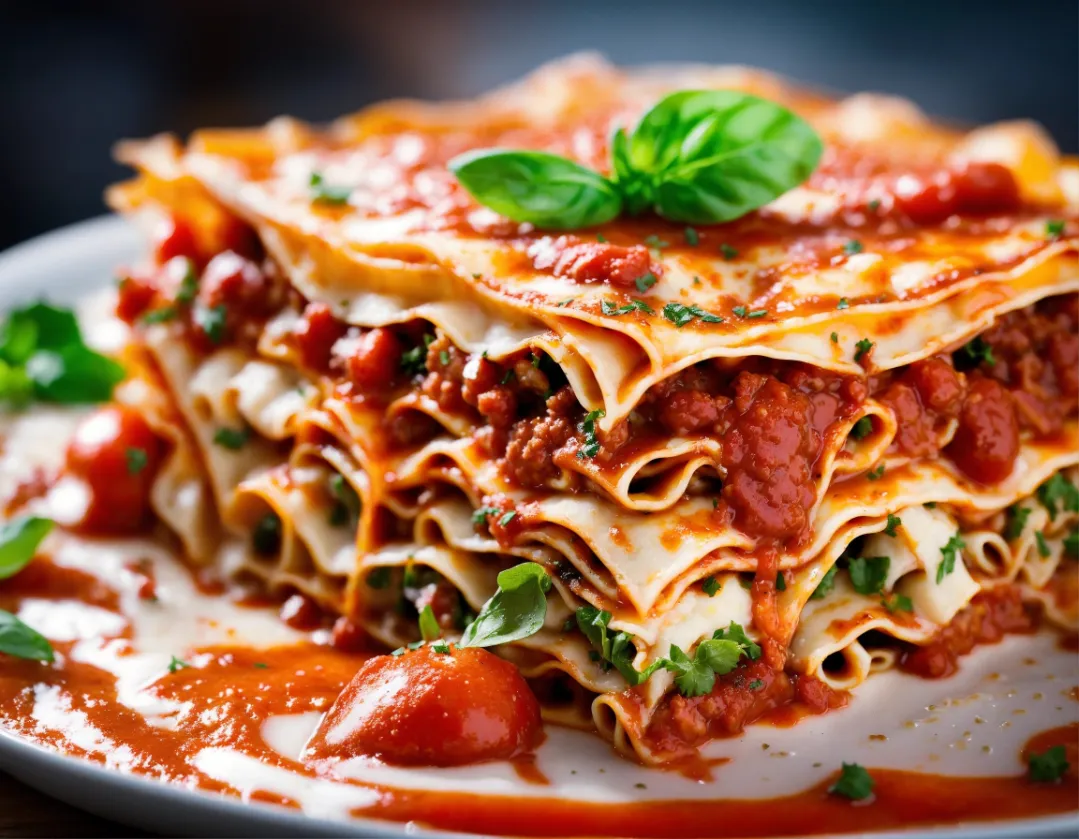Introduction to Lasagna Bolognese
Lasagna Bolognese, a crown jewel in the realm of Italian cuisine, originates from the lush landscapes of Bologna, Italy. Esteemed for its rich history and culinary sophistication, this dish epitomizes the fusion of hearty flavors and meticulous cooking techniques. Lasagna Bolognese sets itself apart from its cheese-heavy global counterparts with a refined mix of thin pasta sheets, robust ragù, and creamy besciamella sauce.
Lasagna Bolognese stands out for its flavor depth and textural complexity, unlike the cheese-heavy American type or ricotta-rich Southern Italian style. Unlike other lasagnas that revel in cheeses like ricotta and mozzarella, Bolognese lasagna depends on a slow-simmered meat sauce and velvety besciamella for flavor balance. This difference highlights Italian cuisine’s regional diversity and Bologna’s culinary artistry. For more insight, delve into the Ultimate Guide to San Giorgio Lasagna Recipe, illustrating its traditional preparation methods.
Ingredients Overview for Lasagna Bolognese
The quintessential Lasagna Bolognese is crafted from a symphony of high-quality ingredients, each playing a vital role in the dish’s authenticity and flavor. At its core are three main components: fresh pasta sheets, ragù Bolognese, and creamy besciamella sauce.
Making the Ragù
Ragù, central to Lasagna Bolognese, has a rich history originating from Renaissance Bologna as a luxurious meat sauce. Its role in Bolognese cuisine is crucial, symbolizing the region’s culinary heritage and the slow food philosophy that values quality ingredients and meticulous, slow cooking.
To prepare an authentic ragù, begin with a soffritto base of finely chopped onions, carrots, and celery, sautéed gently in olive oil or butter until they soften and release their flavors. Next, add ground meat, traditionally a mix of beef and pork, browning it slowly to enhance its savory depth. Pour in a splash of red wine to deglaze the pan, allowing the alcohol to evaporate and leaving behind a rich, concentrated flavor.
Incorporate crushed tomatoes or a passata, stirring into the meat mixture. Season with salt, pepper, and a touch of nutmeg, then let the sauce simmer gently for several hours. This slow cooking process is crucial, as it allows the flavors to meld and intensify. Aromatic herbs like bay leaves, thyme, or rosemary can be added to infuse the ragù with additional layers of flavor.
Achieving the perfect consistency and flavor in ragù requires patience and attention to detail. The sauce should be thick, yet moist, coating the back of a spoon without being overly runny. Taste regularly and adjust the seasoning as needed, ensuring a harmonious balance of savory, rich, and subtly sweet notes. Remember, the best ragù is one that has been given time to develop its full flavor potential, making it the soulful centerpiece of your Lasagna Bolognese. For those keen on mastering this crucial element, exploring professional lasagna making classes can provide invaluable insights.
Preparing the Pasta
The pasta in Lasagna Bolognese plays a critical role, serving as the delicate layers that embrace the ragù and besciamella. Traditional methods of pasta making involve mixing fine Italian “00” flour with eggs to create a smooth, pliable dough. This dough is then kneaded by hand to develop the gluten, ensuring an elastic texture that’s resilient enough to withstand rolling and layering.
Modern shortcuts often include ready-made pasta sheets or no-boil lasagna noodles, which offer convenience and speed up the cooking process. While convenient, these alternatives might alter the texture and flavor provided by fresh homemade pasta. Ideal lasagna sheets should be thin enough to enhance, not overpower, the dish’s other elements, yet strong enough to support the weight of the ragù and besciamella. Rolling and cutting the pasta by hand allows for a custom thickness and a more rustic, authentic experience. Using a pasta machine can achieve uniformly thin sheets, enhancing the delicate layering of the lasagna. The dough should be rolled through the machine multiple times, progressively setting the machine to a thinner setting until the desired thinness is achieved.
The thickness and texture of the pasta are paramount in Lasagna Bolognese. If the pasta is too thick, it overpowers the sauce’s nuanced flavors; if too thin, it may disintegrate during cooking, losing structure. Ideally, pasta sheets should balance thickness, offering a tender bite that blends well with the lasagna’s rich flavors. Perfecting pasta preparation honors Lasagna Bolognese’s tradition and enhances the dish’s culinary excellence. Learn more about the Italian pasta varieties with our article on Mafaldine Pasta, a delightful culinary discovery from Italy.
Assembly, Cooking, and FAQs
Assembling the Lasagna
Assembling Lasagna Bolognese is an art, layering its components to craft a harmonious, tasty experience. Perfect assembly hinges on evenly distributing pasta, ragù, and besciamella, guaranteeing a balanced, flavorful bite.
Start with a thin layer of ragù at the bottom of the baking dish to prevent sticking and establish a flavorful base. Then, lay the first pasta sheets over the ragù, overlapping them as needed to completely cover the surface. On top of the pasta, apply a layer of besciamella sauce, spreading it evenly to cover the pasta sheets. Spoon another layer of ragù over the besciamella, and then sprinkle a generous amount of grated Parmigiano-Reggiano cheese.
Continue layering pasta, besciamella, ragù, and Parmigiano-Reggiano until you use all the ingredients, usually creating three to four layers. The final layer should end with a coating of besciamella topped with a liberal dusting of Parmigiano-Reggiano to achieve a golden, crispy top when baked.
The proportions of ragù and besciamella should make each layer moist and flavorful, avoiding any overly wet or dry texture. Ideally, each component should complement the others, with no single element overpowering the rest. This balanced distribution ensures that the lasagna cooks evenly and each slice holds together, presenting a cohesive and inviting dish.
Baking the Lasagna
Baking is the final, crucial step in the creation of Lasagna Bolognese, where all the flavors meld together under the perfect heat. The optimal temperature for baking lasagna is around 375°F (190°C). This moderate heat allows the lasagna to cook thoroughly without burning the top or edges. Preheating the oven before baking ensures that the lasagna cooks evenly from the moment it enters the oven.
The typical baking time for Lasagna Bolognese ranges from 45 to 60 minutes. This duration allows the layers to heat through, the cheese to melt, and the top to achieve a golden-brown crust. Covering the lasagna with foil for the initial part of the baking process prevents excessive browning. Remove the foil in the last 10-15 minutes to allow the top to crisp up.
A knife or skewer inserted into the center should come out hot, confirming even cooking of the lasagna. Perfect doneness manifests as a bubbly sauce at the edges, a golden-brown crust, and a hot center, indicating thorough heating of the lasagna. The top layer should be crispy and golden, with the cheese melted to a deliciously gooey consistency. Let the lasagna rest for 10-15 minutes after baking to maintain its structure, prevent it from falling apart when served, and allow the flavors to deepen.
Serving and Pairing
Serving Lasagna Bolognese is not just about taste but also presentation and pairing. To serve, use a sharp knife or a lasagna spatula to cut through the layers cleanly, ensuring each slice holds its shape and showcases the distinct layers. Plate each portion carefully, allowing the lasagna’s structure and colors to be visible, enhancing the visual appeal.
When considering side dishes, opt for simplicity to complement the rich flavors of the lasagna. A light, crisp green salad dressed with a balsamic vinaigrette or a selection of steamed seasonal vegetables works well, providing a refreshing contrast to the hearty main dish. For bread, serve a crusty baguette or garlic bread to sop up any remaining sauce on the plate.
FAQs about Lasagna Bolognese
What makes Lasagna Bolognese different from other types of lasagna?
Lasagna Bolognese, unique in its traditional Bolognese ingredients and methods, contrasts with other lasagnas that typically use ricotta or cottage cheese. Instead, it boasts layers of thin, homemade pasta, a rich and savory ragù of mixed meats, and creamy besciamella sauce. Consequently, this blend emphasizes flavor and texture harmony over cheese dominance.
Can I prepare Lasagna Bolognese in advance?
Yes, Lasagna Bolognese is an excellent dish for advance preparation. You can assemble the lasagna and refrigerate it for a day or two before baking, allowing the flavors to meld together and deepen. Alternatively, you can bake the lasagna completely, let it cool, and then freeze it. When you’re ready to serve, simply reheat it in the oven. This make-ahead aspect makes it a practical choice for entertaining or for preparing a family meal during a busy week.
What are the key factors in choosing ingredients for Lasagna Bolognese?
The quality of the ingredients is paramount in creating an authentic Lasagna Bolognese. For the pasta, opt for homemade sheets or high-quality store-bought options that mimic the texture and taste of homemade pasta. To prepare the ragù, use fresh, high-quality meats, and for a silky besciamella sauce, incorporate real butter, flour, and whole milk. Freshly grated Parmigiano-Reggiano cheese adds the final touch of authenticity and flavor.
LSI and NLP Keywords
- Traditional Italian cuisine
- Pasta layers
- Béchamel sauce
- Meat sauce preparation
- Cooking time and temperature
- Recipe variations
- Homemade pasta tips
- Culinary techniques in Bologna
Conclusion about Lasagna Bolognese
Lasagna Bolognese transcends being just a dish; it’s a rich culinary tradition, embodying Bolognese cuisine’s essence. Crafting it is a labor of love, blending Italian culinary history with the joy of cooking and eating. Through meticulous layering of homemade pasta, savory ragù, and creamy besciamella, it delivers a flavor and texture symphony, showcasing Italian cooking artistry.
Moreover, this dish connects us to Italy’s rich cultural heritage, where food is a life cornerstone. Suitable for festive gatherings, family dinners, or special occasions, Lasagna Bolognese symbolizes Italian cuisine’s timeless appeal, uniting people in shared enjoyment.
Embracing traditional preparation methods pays homage to ancestral culinary wisdom, immersing us in a centuries-old ritual. Lasagna Bolognese encourages us to savor each bite, celebrating the cooking joy and the company’s warmth, thus standing as a gastronomy revered classic.



